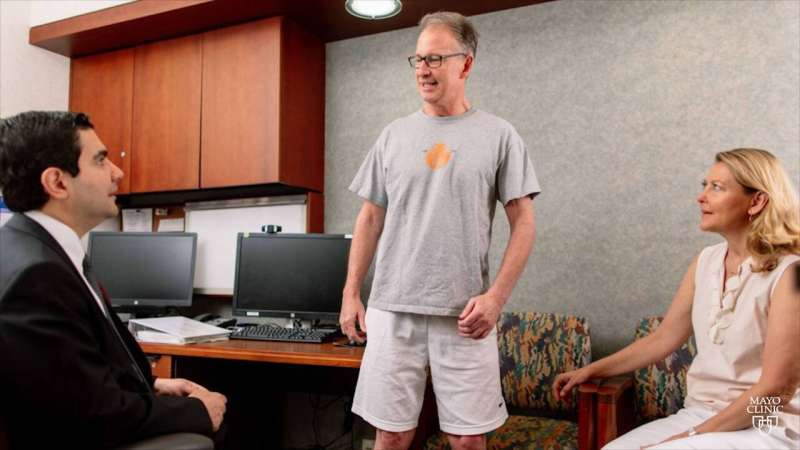Case report: Stem cells a step toward improving motor, sensory function after spinal cord injury

Stem cells derived from a patient's own fat offer a step toward improving—not just stabilizing—motor and sensory function of people with spinal cord injuries, according to early research from Mayo Clinic.
A clinical trial enrolled 10 adults to treat paralysis from traumatic spinal cord injury. After stem cell injection, the first patient demonstrated improvement in motor and sensory functions, and had no significant adverse effects, according to a case report published in Mayo Clinic Proceedings.
As a phase I multidisciplinary clinical trial, the study tests the safety, side effects and ideal dose of stem cells. Early trial findings show that patient response varies. The Mayo team plans to continue analyzing patient responses, and further results will be published on the other nine trial participants.
"In this case report, the first patient was a superresponder, but there are other patients in the trial who are moderate responders and nonresponders," says Mohamad Bydon, M.D., a Mayo Clinic neurologic surgeon and first author of the report. "One of our objectives in this study and future studies is to better delineate who will be a responder and why patients respond differently to stem cell injections.
"The findings to date will be encouraging to patients with spinal cord injuries, as we are exploring an increasing array of options for treatment that might improve physical function after these devastating injuries."
Between 250,000 and 500,000 people worldwide suffer a spinal cord injury each year, often with life-changing loss of sensory and motor function, according to the World Health Organization. Up to 90% of these cases are from traumatic causes.
All subjects enrolled in this study received fat-derived stem cell treatment, which is experimental and is not approved by the Food and Drug Administration (FDA) for large-scale use. However, the FDA allowed its use in this research.
In the case report, the patient, then 53, injured the spinal cord in his neck in a 2017 surfing accident. He suffered a complete loss of function below the level of injury, meaning he could not move or feel anything below his neck. He had surgery to decompress and fuse his cervical vertebrae. Over the next few months, with physical and occupational therapy, he regained limited ability to use his arms and legs, and some sensory function improved. However, his progress plateaued at six months after his injury.
The patient enrolled in the study nine months after his injury. His stem cells were collected by taking a small amount of fat from his abdomen. Over eight weeks, the cells were expanded in the laboratory to 100 million cells. Then the stem cells were injected into the patient's lumbar spine, in the lower back, 11 months after his injury.
"We want to intervene when the physical function has plateaued, so that we do not allow the intervention to take credit for early improvements that occur as part of the natural history with many spinal cord injuries. In this case, the patient was injected with stem cells nearly one year after his injury," Dr. Bydon says.
The patient was observed at baseline and at regular intervals over 18 months following injection. His physical therapy scores improved. For example, in the 10-meter walk test, the patient's baseline of 57.72 seconds improved at 15 months to 23 seconds. And in the ambulation test, the patient's baseline of 635 feet for 12.8 minutes improved at 15 months to 2,200 feet for 34 minutes.
The patient's occupational therapy scores also improved, such as grip and pinch strength, and manual dexterity. His sensory scores improved, with pin prick and light touch tests, as did his mental health score.
The stem cells migrate to the highest level of inflammation, which is at the level of spinal cord injury, but the cells' mechanism of interacting with the spinal cord is not fully understood, Dr. Bydon says. As part of the study, investigators collected cerebrospinal fluid on all of the patients to look for biological markers that might give clues to healing. Biological markers are important because they can help identify the critical processes that lead to spinal cord injury at a cellular level and could lead to new regenerative therapies.
"Regenerative medicine is an evolving field," says Wenchun Qu, M.D., Ph.D., a Mayo Clinic physiatrist and pain specialist, and senior author of the report. "Mayo's research and use of stem cells are informed by years of rigorous scientific investigation. We strive to ensure that patients who receive stem cells are fully educated in the risks, benefits, alternatives and unknowns about these therapies. Through our clinical trials with stem cells, we are learning from and improving these procedures."
Further study is needed to scientifically verify the effectiveness of stem cell therapy for paralysis from spinal cord injury, the authors note. It is uncertain when or if this procedure will have FDA approval for routine clinical care.
More information: Mohamad Bydon et al. CELLTOP Clinical Trial: First Report From a Phase 1 Trial of Autologous Adipose Tissue–Derived Mesenchymal Stem Cells in the Treatment of Paralysis Due to Traumatic Spinal Cord Injury, Mayo Clinic Proceedings (2019). DOI: 10.1016/j.mayocp.2019.10.008














